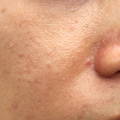
Sam
SAY HELLO TO YOUR SKINS BFF - ACIDS!
If you are experiencing breakouts then don’t panic - there are plenty of amazing skincare ingredients out there that will help to tackle spots and blemishes. Right at the very top of the list are skincare acids; absolute must-have skincare actives to include in your routine if you have blemish prone skin.

“shift dead cells from the skins surface to brighten + unclog pores, reducing blackheads + spots.”
WHAT ARE SKINCARE ACIDS?
Skincare acids can be found in loads of different products (anything from a cleanser to an overnight cream), and are mainly used as chemical exfoliants to loosen the bonds between skin cells. This helps to shift dead cells from the skins surface, which makes many acids go-to ingredients for not only brightening skin, but also for getting rid of unwanted dirt, oil and skin debris that can clog pores and lead to breakouts.
However, there are quite a few skincare acids out there and some will suit skin prone to sensitivity, while others are more potent to give a more intense result. They also have a range of different skincare benefits, so here’s our need-to-know essential guide:
AHAs, BHAs + PHAs
Most skincare acids are classed as either alpha hydroxy acids (AHAs), beta hydroxy acids (BHAs) or polyhydroxy acids (PHAs).
ALPHA HYDROXY ACIDS - AHAs
Water soluble and work mainly on the skin surface, so are generally used to deliver brighter, more radiant skin.
BETA HYDROXY ACIDS - AHAs
Oil soluble and so can penetrate more deeply into skin and bind themselves to sebum, so are great for unclogging pores (which we why we love a BHA as they are brilliant at helping to clear congested skin! 💛).
POLYHYDROXY ACID - PHAs
Like AHA's, PHAs are water soluble but they have larger molecule size so they penetrate the skin less deeply and more slowly, which means they are less irritating and great for sensitive skin. For more information, read our detailed blog on PHAs

ALPHA HYDROXY ACIDS - AHAs
Glycolic Acid
A small molecule AHA which can penetrate more deeply than other AHAs, so it can help to stimulate collagen production to tackle lines and wrinkles as well as helping to brighten and even out skin tone. The downside is that it can cause irritation if used in high levels so you may need to build up tolerance when first using it.
Lactic Acid
A larger molecule AHA which means it can’t penetrate as deeply as Glycolic. Although the results from using Lactic vs Glycolic might not be as dramatic, the benefit of using a larger molecule size like Lactic Acid is that people who have more sensitive skin might tolerate it better. Add it into your routine to brighten skin, improve skin texture and reduce the signs of pigmentation. Bonus - it also helps to draw moisture to the skin so can help skin prone to dryness too.
Malic Acid
Derived from apples, Malic Acid is increasing in popularity because of its large molecule size, making it super gentle. Like Lactic, it also helps to draw moisture to the skin. So although Malic might not pack as much of a punch as Latic or Glycolic, it’s again good for those with sensitive skin. It also can help to reduce the production of melanin, helping to prevent hyperpigmentation.
Mandelic Acid
Derived from bitter almonds, Mandelic Acid helps to brighten and even skin tone in line with other AHAs. However, it’s also useful to fight blemishes by helping to control excess sebum production. It’s larger molecule size also means its gentler than some other AHAs.

BETA HYDROXY ACIDS - BHAs
There is really only one BHA that is commonly used in skincare but its the one most of us know...
Salicylic Acid
An absolute hero ingredient for helping to fight blemishes (you might have noticed it’s in quite a few of our Clear Skin Days products!). It is often recommended by experts to help treat mild acne, and it works by penetrating skin to help dissolve the debris that can clog up pores, as well as acting as an anti-inflammatory to calm blemishes. Basically, its a must-have ingredient for tackling acne and oily skin..
POLYHYDROXY ACIDS - PHAs
Galactose
Made from the sugar found in milk, this PHA is used less than others but nevertheless, works well on exfoliating your skin gently
Lactobionic
Another milk based PHA, its an oxidised form of milk and works as both a humectant and exfoliator
Gluconolactone
The most popular PHA, its the one we use after all - this one has additional benefits. Made from Gluconic acid, it naturally occurs in honey, fruit and wine.
HYALURONIC ACID - HA
Hyaluronic Acid works completely differently to AHAs / BHAs and PHAs, so the name is a bit of a decoy.
HA is found naturally in the body as a sugar, and holds water to keep moisture in our skin and joints. You will spot HA in pretty much any hydrating skincare product out there, and it works by drawing in moisture to skin to keep skin plumped and dewy. Basically, it’s not a chemical exfoliator like the rest of the acids mentioned above, but we thought it was mentioning in case of the name confusion. Plus it’s a total powerhouse of a skincare ingredient so we love to talk about HA whenever we get the chance.

HOW SHOULD I USE SKINCARE ACIDS?
So now that you know your Mandelic from your Salicylic, how should you start introducing acids into your skincare routine?
For Hyaluronic Acid, this can be introduced anytime as its sole purpose is to hydrate your skin. For exfoliating acids (AHAs, BHAs and PHAs), if you are new to acids and your skin is prone to sensitivity, then you should ideally introduce an acid gradually into your routine a couple of times a week.
To be safe, always check the “how to use” on the packaging label to provide the right guidance on how many times a week you should use the product. And lastly, we hate to nag but please remember to always wear sunscreen!
If you feel ready to try a AHA, BHA or PHA, you should take a look at our range as we include skin friendly acids to help with exfoliation and hydration. In particular, our BHA PHA Pore Refining Solution, the newest addition to our range and is an excellent exfoliator and hydrator - we love the dual benefits of this one!
It's a gentle serum suitable for sensitive skin that can easily be incorporated into regimes. Formulated with Betaine Salicylate (BHA) and Chamomile extract, its applied to cleansed skin before moisturisers to help reduce pore appearance and blackhead formation, whilst keeping skin hydrated, smooth & glowing.
GET IN TOUCH
We hope that you've found this blog helpful - if you have any questions or would like to share your skincare journey with us, we'd love to hear from you. You can get in touch via the form below or by DM on IG.






